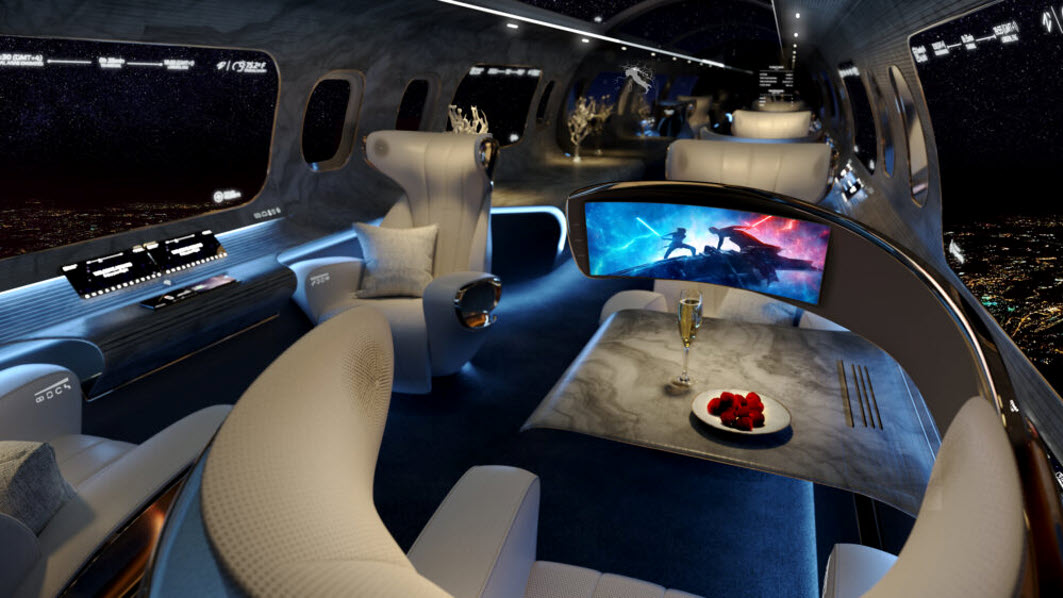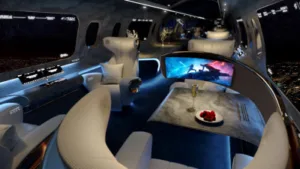In the first of these articles, I looked at ideas in automotive and TV design that are enabled by the flexibility of OLEDs. Today I’m looking at an interesting use in aviation. (OLEDs –Revolutionizing the Essence of Product Design – Part 1)

Boeing and Airbus are experimenting with groundbreaking large-format OLED displays which will disrupt the aircraft cabin industry with more intuitive, immersive, and beautiful cabin designs. Simulations have shown that eliminating the break in the fuselage for the windows improves the aerodynamics of a plane. The challenge is to provide the passenger with a comparable view of the outside world, a type of augmented reality for the airline industry. Rosen Aviation has come up with the Maverick cabin concept that embraces technology at the forefront of its design. Shortlisted for a Crystal Cabin Award this year:
–“Rosen aims to shift the travel paradigm by creating a cabin so rich in technology it completely redefines the passenger experience.”
The concept uses the latest in sensor and display technology to create a cabin that feels like something out of a science fiction movie. Familiar high-end touches like wireless charging and touchscreen control surfaces are accompanied by less common components, such as the huge OLED.
 Figure 1: Rosen Aviation Displays and ‘Virtual’ Buttons
Figure 1: Rosen Aviation Displays and ‘Virtual’ Buttons
Seat controls are integrated into smart surfaces in the armrest. Buttons, known as ‘smart sensors,’ were developed by Rosen Aviation.
The Maverick cabin uses integrated surfaces with backlit control indicators to replace bulky mechanical switches. Working through microperforated substrates, the controls are proximity activated and provide haptic feedback to the user. Taking things, a step further, Rosen is also developing fully holographic keyboards for working in the cabin.
Menus will also be holographic, minimizing touchpoints and reducing the potential for contamination of surfaces. The company has further talked of the integration of AI into the sensors, so that these smart surfaces can begin to predict a user’s intention.
Large virtual windows and skylights, coupled with the olive wood veneer, give the cabin a light, modern ambiance. The cabin is essentially windowless, which has the potential to make for a somewhat claustrophobic experience. However, Rosen overcomes this with the use of OLED displays to create virtual windows instead. These displays show a real-time image of the outside world, or can be used for business presentations, flight information, or even inflight entertainment.
 Figure 2: OLED Displays Replacing Windows. Image:Rosen Aviation
Figure 2: OLED Displays Replacing Windows. Image:Rosen Aviation
Speaking to Simple Flying earlier this year, Rosen’s SVP Strategy, Lee Clark, and VP Product Engineering, Darrell Finneman, noted the benefits that OLEDs bring, saying,
“Of the many advantages offered by OLEDs, are the endless opportunities for transparency and flexibility. With these new features, virtual windows and skylights are made possible in several different form factors, whether it be a flexible display tied to outside cameras, or a transparent display providing key flight information juxtaposed to traditional windows”.
The executives also noted the potential for augmented reality to be integrated into these alternative windows. Things like a star map, pointing out the night time constellations as they pass by the window, or an interactive feed displaying interesting features on the ground below – it’s a moving map concept like no other that has gone before.
 Figure 3: Individual screens pivot out from the seats. Image:Rosen Aviation
Figure 3: Individual screens pivot out from the seats. Image:Rosen Aviation
As well as the large displays on the cabin walls, the Maverick features personal pivoting seat displays, so that every passenger can enjoy their choice of entertainment onboard. In February, supersonic aircraft company Aerion announced that it would be working with Rosen for its cabin management and technology system (CTMS) for the forthcoming business jet AS2. The AS2 was to be the first supersonic business jet the world has ever seen, and with Rosen’s blue sky thinking behind it, we were looking forward to some delightful touches in the cabin.
 Figure 4: Supersonic AS2. Image:Aerion Supersonic
Figure 4: Supersonic AS2. Image:Aerion Supersonic
The AS2 may never become a reality; with Aerion now largely shut down, the future of this collaboration is in doubt. Nevertheless, that doesn’t mean it’s the end of the Maverick concept. Rosen’s executives previously outlined their goals for the future, saying;
“Our plans going forward are to continue development of the many technologies demonstrated in The Maverick cabin. That is what made Maverick so exciting. It was not merely CGI smoke and mirrors but represented actual Rosen development projects. Seeing the video is one thing, getting to see and feel working proof-of-concepts takes the experience to a whole new level.”
The concepts that Rosen has woven into the Maverick cabin design. Many of the touchless, technology-led elements are even more relevant in our current, hygiene-focused environment. Perhaps this is indeed the future of business jet cabins. The Maverick cabin concept has been shortlisted for 2021’s Crystal Cabin Awards. Winners will be announced at the virtual Aircraft Interiors Expo (14 – 16 September 2021). Many of these ideas were demonstrated by Boeing in one of their concept aircraft. (BY)
Barry Young is the CEO of the OLED Association

